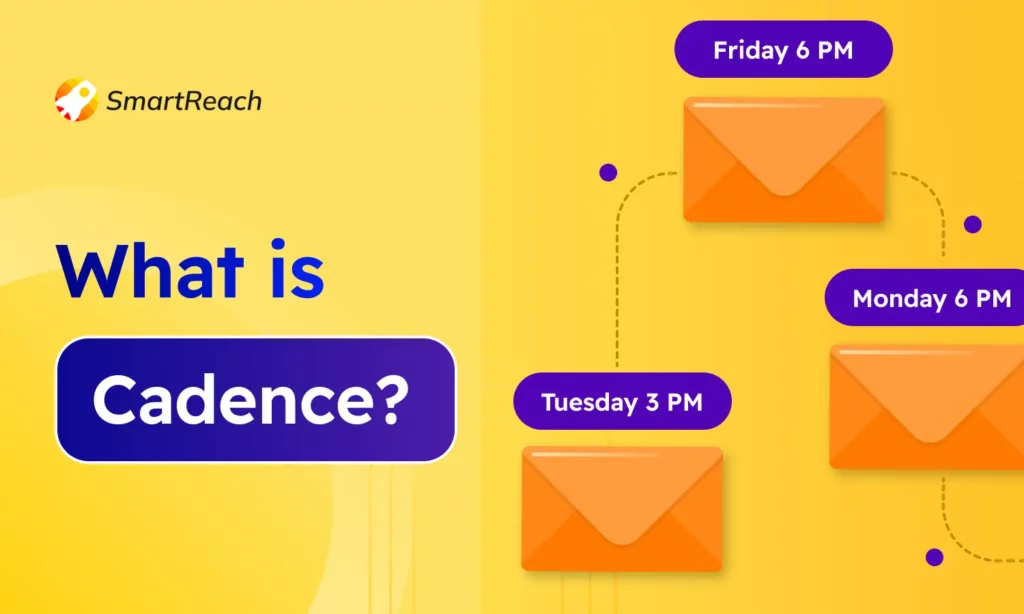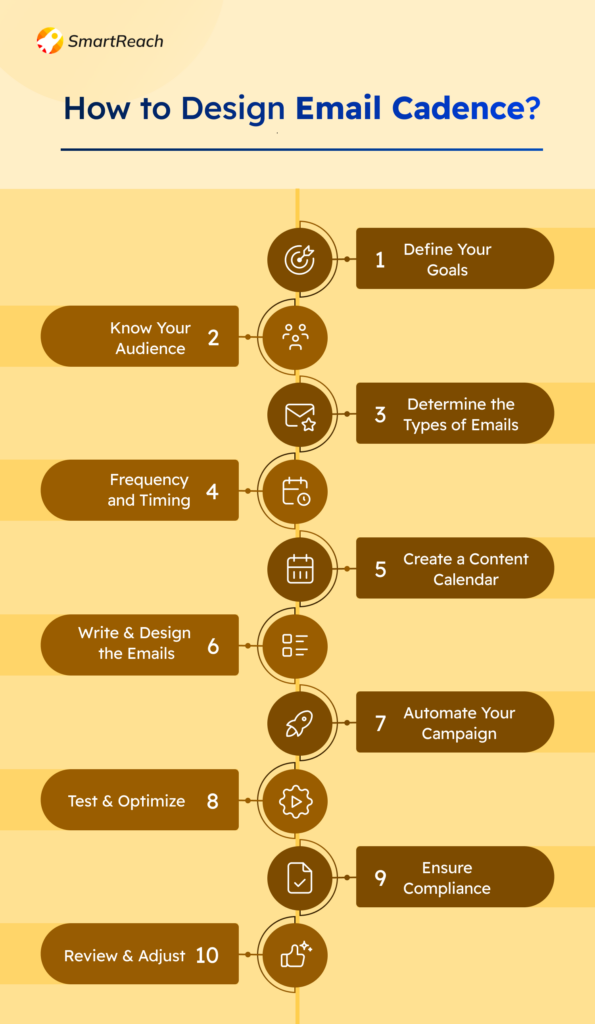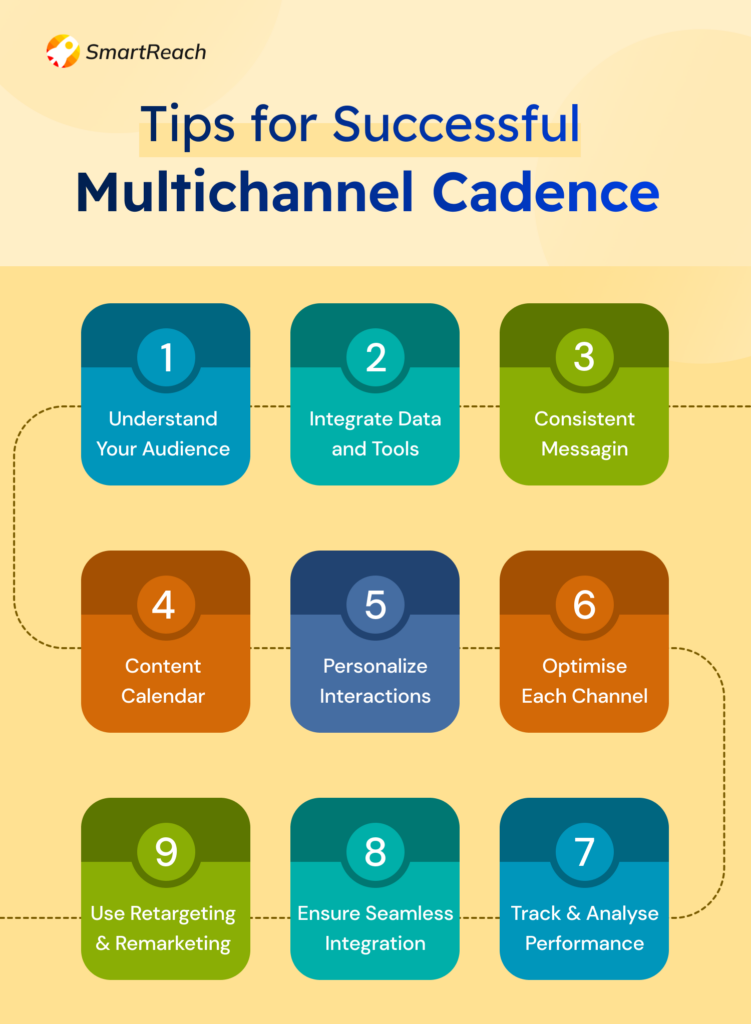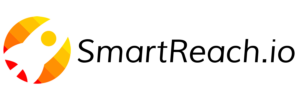Cadence
Back to Glossary

Implementing an effective cadence strategy is important for businesses that want to make a big impact with their marketing and build strong relationships with their audience.
Using email or multichannel outreach to carefully plan the timing and frequency of messages can greatly improve engagement, conversion rates, and how people see your brand.
In this guide, we’ll talk about how to use email and multichannel cadences to communicate with your customers.
We’ll discuss why they’re helpful, how to use them, and some tools that make it easier. By using these cadences, businesses can better connect with customers, make more sales, and grow, even in a tough market.
What is email cadence?
Email cadence refers to the timing and frequency of emails you send to your subscribers or prospects. It’s about finding the sweet spot between sending too few emails (and missing out on engagement opportunities) and sending too many emails (and annoying your subscribers).
Here’s a breakdown of the concept:
- Frequency: This refers to how often you send emails. It could be daily, weekly, monthly, or something else entirely.
- Timing: This refers to the specific day and time you send your emails. There are ideal times to send emails that can improve open rates and click-through rates.
What is the benefit of writing an optimal email cadence?
An optimal email cadence offers several benefits for your email marketing efforts:
Boosts Engagement
By sending emails at the right frequency and timing, you can keep your audience engaged with your brand. If you send emails too infrequently, they won’t forget about you, and you won’t annoy them by sending too many.
Increases Open and Click-Through Rates
When people are interested in your content, they’re more likely to open your emails and click on your links. An optimal cadence helps ensure your emails are reaching people when they’re most receptive.
Improves Conversions
The ultimate goal of email marketing is often to drive conversions, whether that’s a sale, a download, or a sign-up. An optimal cadence can help you nurture leads and move them through the sales funnel more effectively.
Strengthens Relationships
Regular email communication helps you build relationships with your subscribers. An optimal cadence allows you to stay in touch without being intrusive.
Reduces Unsubscribe Rates
Nobody likes to feel bombarded with emails. An optimal cadence helps reduce the chances of subscribers getting annoyed and unsubscribing from your list.
How to design email cadence?
Creating an email cadence involves planning and scheduling a series of emails to engage with your audience effectively. Here are the steps to create an effective email cadence:
Step 1: Define Your Goals
Identify Objectives
- What do you want to achieve with your email campaign?
- Examples: Increase sales, nurture leads, improve customer retention, boost brand awareness.
Set Specific Goals
- Make your goals specific, measurable, achievable, relevant, and time-bound (SMART).
- Example: Increase email open rates by 15% in three months.

Step 2: Know Your Audience
Segment Your Audience
- Divide your audience based on criteria such as demographics, past behavior, purchase history, and engagement level.
- Example segments: New subscribers, active customers, inactive subscribers, high-value customers.
Create Audience Personas
- Develop detailed profiles for each segment.
- Include information like interests, pain points, and preferences.
Step 3: Determine the Types of Emails
List Email Types
- Welcome emails
- Educational content
- Promotional emails
- Newsletters
- Re-engagement emails
- Transactional emails
- Event invitations
Map Email Types to Customer Journey Stages
- Awareness: Educational content, newsletters
- Consideration: Case studies, testimonials
- Decision: Promotional emails, special offers
- Retention: Loyalty programs, re-engagement emails
Step 4: Plan the Frequency and Timing
Decide Frequency
- Determine how often you will send emails to each segment.
- Example: Weekly newsletters, bi-weekly promotional emails.
Choose Optimal Timing
- Analyze past data to determine the best days and times to send emails.
- Consider the time zones of your audience.
Step 5: Create a Content Calendar
Outline the Schedule
- Plan your email schedule for the next few months.
- Include dates for each email send.
Detail Content Themes
- Assign topics/themes for each email.
- Example: Week 1 – Introduction, Week 2 – Product benefits, Week 3 – Customer testimonials.
Step 6: Write and Design the Emails
Craft Compelling Subject Lines
- Use clear, concise, and engaging subject lines.
- A/B test different subject lines.
Personalize the Content
- Use recipient’s name and tailor the content to their interests and behaviors.
Include Clear CTAs
- Ensure every email has a clear call-to-action.
- Example CTAs: “Shop Now”, “Learn More”, “Download”.
Design for Responsiveness
- Ensure emails are visually appealing and render well on all devices.
Step 7: Automate Your Campaign
Choose an Email Marketing Platform
- Select a platform like Mailchimp, HubSpot, or ActiveCampaign.
Set Up Automation Workflows
- Create workflows for different email sequences.
- Example workflows: Welcome series, post-purchase follow-up, abandoned cart reminders.
Step 8: Test and Optimize
A/B Test Elements
- Test subject lines, email content, CTAs, and send times.
- Use the results to optimize your emails.
Monitor Key Metrics
- Track open rates, click-through rates, conversion rates, and unsubscribe rates.
- Use these metrics to assess the performance of your emails.
Refine Your Strategy
- Based on performance data, tweak your email content, frequency, and targeting.
Step 9: Ensure Compliance
Understand Regulations
- Familiarize yourself with email marketing laws such as CAN-SPAM Act, GDPR, and others.
Include Necessary Elements
- Make sure each email includes a clear unsubscribe link and your business’s physical address.
Step 10: Review and Adjust
Regularly Review Performance
- Analyze the success of your email campaigns on a regular basis.
- Look for trends and patterns in the data.
Make Adjustments
- Continuously improve your email cadence based on feedback and performance metrics.
- Update your content calendar with new ideas and strategies.
Sample email cadence for lead nurturing

What is multichannel cadence?
A multichannel cadence builds on the concept of email cadence by incorporating outreach across various communication channels. It’s a strategic approach to reaching out to potential customers or subscribers using a planned sequence of interactions through different channels, like email, phone calls, social media messages, WhatsApp and even direct mail.
Here’s how multichannel cadence expands on email cadence:
- Multi-pronged Approach: Instead of relying solely on email, you reach out through various channels to increase the chances of getting noticed and engaging your audience.
- Variety in Communication: By using different channels, you can tailor your message format to each platform’s strengths. For example, social media might be better for quick updates, while emails can go more in-depth.
- Omnichannel Experience: A multichannel cadence, when done well, creates a cohesive brand experience across different touchpoints.
Sample multichannel cadence for lead nurturing

How can you make the most out of a multichannel cadence?
To make the most out of a multichannel cadence, you need to strategically plan and execute your interactions across various channels to ensure a cohesive and effective campaign. Here are detailed steps and tips to maximize the impact of your multichannel cadence:
Understand Your Audience
Audience Segmentation: Segment your audience based on demographics, behaviors, preferences, and past interactions.
Channel Preferences: Identify which channels your audience prefers and is most active on.
Integrate Data and Tools
Centralized Data Management: Use a CRM system to centralize data from all channels for a unified view of each customer.
Marketing Automation: Utilize marketing automation tools to streamline and manage your campaigns across multiple channels.
Develop a Consistent Messaging Strategy
Unified Brand Voice: Maintain a consistent tone and style across all channels to reinforce your brand identity.
Tailored Content: Adapt your message to fit the format and strengths of each channel while keeping the core message consistent.
Create a Comprehensive Content Calendar
Scheduled Touchpoints: Plan and schedule interactions on different channels, ensuring no overlap or excessive frequency.
Content Planning: Prepare content in advance, tailored to each channel’s format and audience expectations.
Personalize Interactions
Use Data for Personalization: Utilize customer data to personalize messages, offers, and recommendations on each channel.
Dynamic Content: Implement dynamic content that changes based on user behavior and preferences.
Optimize Each Channel
Email: Focus on compelling subject lines, personalized content, and clear CTAs.
LinkedIn: Engage with interactive content, respond to comments, and use targeted ads.
SMS: Send timely and concise messages with a strong call to action.
Phone Calls: Personalize calls based on previous interactions and provide value in the conversation.
WhatsApp: Use WhatsApp to send personalized messaging to stand out.
Track and Analyze Performance
Monitor KPIs: Track key performance indicators (KPIs) such as open rates, click-through rates, conversion rates, and engagement metrics for each channel.
Analyze Data: Use analytics tools to understand the performance of each touchpoint and channel.
Adjust and Optimize: Continuously refine your strategy based on performance data and feedback.
Ensure Seamless Integration
Cross-Channel Cohesion: Ensure that transitions between channels are smooth and that each touchpoint complements the others.
Unified Customer Experience: Provide a seamless and coherent experience, regardless of the channel the customer engages with.
Use Retargeting and Remarketing
Retargeting Campaigns: Use retargeting ads to re-engage users who have interacted with your content but have not converted.
Cross-Channel Remarketing: Implement remarketing strategies that follow users across different channels to reinforce your message and encourage action.

How to measure email & multichannel cadence?
Measuring the effectiveness of your email and multichannel cadence involves tracking various key performance indicators (KPIs) and using analytics tools to gather data. Here’s a concise guide on how to do it:
Email Cadence
- Open Rate
- What: Percentage of recipients who open your email.
- Why: Indicates the effectiveness of your subject lines and send times.
- Benchmark: Aim for 15-25%.
- Click-Through Rate (CTR)
- What: Percentage of recipients who click on links within your email.
- Why: Measures engagement and the relevance of your content.
- Benchmark: Aim for 2-5%.
- Conversion Rate
- What: Percentage of recipients who complete a desired action (purchase, sign-up).
- Why: Shows the effectiveness of your email in driving actions.
- Benchmark: Varies by industry but generally around 2-5%.
- Bounce Rate
- What: Percentage of emails that could not be delivered.
- Why: High bounce rates can affect your sender reputation.
- Benchmark: Keep it below 2%.
- Unsubscribe Rate
- What: Percentage of recipients who opt out of your emails.
- Why: Indicates if your frequency or content is off-putting.
- Benchmark: Aim for below 0.5%.
- List Growth Rate
- What: Rate at which your email list is growing.
- Why: Ensures you’re reaching a larger audience over time.
- Benchmark: Varies, aim for a steady increase.
Multichannel Cadence
- Engagement Rate
- What: Overall interaction across all channels (likes, shares, comments, clicks).
- Why: Measures how well your audience is interacting with your content.
- Benchmark: Depends on the channel, aim for consistent engagement growth.
- Response Rate
- What: Percentage of direct responses (replies to emails, messages).
- Why: Indicates the effectiveness of your outreach.
- Benchmark: Varies by industry and channel.
- Conversion Rate
- What: Percentage of interactions that result in a desired action.
- Why: Measures the overall effectiveness of your multichannel strategy.
- Benchmark: Varies by industry.
- Channel-Specific Metrics
- Email: Open and click-through rates.
- Social Media: Engagement metrics (likes, shares, comments).
- SMS: Response rate and click-through rate.
- Calls: Call completion and follow-up rates.
- LinkedIn: Connection requests accepted, message replies.
- Customer Journey Metrics
- Touchpoint Analysis: Track which channels and sequences lead to conversions.
- Attribution Modeling: Assign credit to different channels to understand their impact on the customer journey.
- Customer Satisfaction
- Feedback Surveys: Collect feedback post-interaction to gauge satisfaction.
- Net Promoter Score (NPS): Measure customer loyalty and likelihood to recommend.
Top email & multichannel cadence tools
Here are some top tools for managing and optimizing email and multichannel cadences:
Email Cadence Tools
SmartReach.io
- Features: Email outreach automation, follow-ups, personalization, and analytics.
- Best For: Sales teams, recruiters, and marketers looking for automated email outreach with advanced personalization and tracking capabilities.
Mailchimp
- Features: Email marketing, automation, analytics, and A/B testing.
- Best For: Small to medium-sized businesses.
HubSpot
- Features: Email marketing, CRM integration, automation, analytics, and A/B testing.
- Best For: Businesses of all sizes, particularly those needing robust CRM integration.
Constant Contact
- Features: Email marketing, automation, event marketing, and social media tools.
- Best For: Small businesses and nonprofits.
SendinBlue
- Features: Email marketing, SMS marketing, automation, transactional emails, and CRM.
- Best For: Small to medium-sized businesses looking for an affordable all-in-one solution.
ActiveCampaign
- Features: Email marketing, marketing automation, CRM integration, and advanced segmentation.
- Best For: Small to medium-sized businesses focused on automation and CRM integration.
Multichannel Cadence Tools
SmartReach.io
- Features: Email outreach automation, personalized follow-ups, multichannel sequencing, and detailed analytics.
- Best For: Sales teams and marketers seeking a comprehensive solution for outreach across multiple channels, including email, LinkedIn, social texting platforms, calls, and SMS.
HubSpot
- Features: Email marketing, social media management, CRM, live chat, and automation.
- Best For: Businesses of all sizes, especially those looking for comprehensive CRM and marketing integration.
Marketo
- Features: Email marketing, social media, account-based marketing, and robust analytics.
- Best For: Medium to large enterprises needing advanced marketing automation.
Salesforce Marketing Cloud
- Features: Email marketing, social media marketing, SMS, advertising, and customer journey mapping.
- Best For: Large enterprises looking for powerful integration with Salesforce CRM.
ActiveCampaign
- Features: Email marketing, SMS, CRM integration, automation, and site tracking.
- Best For: Small to medium-sized businesses focused on deep automation and customer relationship management.
Klaviyo
- Features: Email marketing, SMS marketing, automation, and detailed analytics.
- Best For: E-commerce businesses looking for robust integration with e-commerce platforms.
Takeaway from cadence
In conclusion, both email and multichannel cadences are essential components of an effective marketing strategy. Email cadence focuses on the timing and frequency of emails to engage with subscribers, while multichannel cadence expands this approach to include outreach across various communication channels.
The benefits of optimizing your cadence include increased engagement, higher open and click-through rates, improved conversions, strengthened relationships with your audience, and reduced unsubscribe rates.
To design an effective cadence, it’s crucial to define your goals, understand your audience, determine the types of emails or interactions, plan the frequency and timing, create a content calendar, write and design your content, automate your campaigns, test and optimize your strategy, ensure compliance with regulations, and continuously review and adjust your approach based on performance metrics.
By implementing a well-designed cadence and leveraging the right tools, businesses can effectively engage with their audience, drive conversions, and build lasting relationships that contribute to long-term success.

